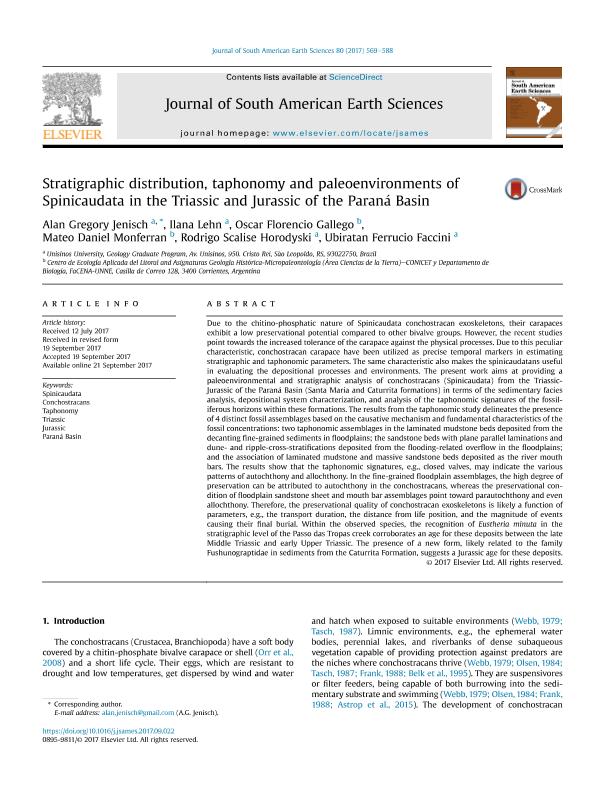Mostrar el registro sencillo del ítem
dc.contributor.author
Jenisch, Alan Gregory
dc.contributor.author
Lehn, Ilana
dc.contributor.author
Gallego, Oscar Florencio

dc.contributor.author
Monferran, Mateo Daniel

dc.contributor.author
Horodyski, Rodrigo Scalise
dc.contributor.author
Faccini, Ubiratan Ferrucio
dc.date.available
2018-09-21T17:35:49Z
dc.date.issued
2017-12
dc.identifier.citation
Jenisch, Alan Gregory; Lehn, Ilana; Gallego, Oscar Florencio; Monferran, Mateo Daniel; Horodyski, Rodrigo Scalise; et al.; Stratigraphic distribution, taphonomy and paleoenvironments of Spinicaudata in the Triassic and Jurassic of the Paraná Basin; Pergamon-Elsevier Science Ltd; Journal of South American Earth Sciences; 80; 12-2017; 569-588
dc.identifier.issn
0895-9811
dc.identifier.uri
http://hdl.handle.net/11336/60577
dc.description.abstract
Due to the chitino-phosphatic nature of Spinicaudata conchostracan exoskeletons, their carapaces exhibit a low preservational potential compared to other bivalve groups. However, the recent studies point towards the increased tolerance of the carapace against the physical processes. Due to this peculiar characteristic, conchostracan carapace have been utilized as precise temporal markers in estimating stratigraphic and taphonomic parameters. The same characteristic also makes the spinicaudatans useful in evaluating the depositional processes and environments. The present work aims at providing a paleoenvironmental and stratigraphic analysis of conchostracans (Spinicaudata) from the Triassic-Jurassic of the Paraná Basin (Santa Maria and Caturrita formations) in terms of the sedimentary facies analysis, depositional system characterization, and analysis of the taphonomic signatures of the fossiliferous horizons within these formations. The results from the taphonomic study delineates the presence of 4 distinct fossil assemblages based on the causative mechanism and fundamental characteristics of the fossil concentrations: two taphonomic assemblages in the laminated mudstone beds deposited from the decanting fine-grained sediments in floodplains; the sandstone beds with plane parallel laminations and dune- and ripple-cross-stratifications deposited from the flooding-related overflow in the floodplains; and the association of laminated mudstone and massive sandstone beds deposited as the river mouth bars. The results show that the taphonomic signatures, e.g., closed valves, may indicate the various patterns of autochthony and allochthony. In the fine-grained floodplain assemblages, the high degree of preservation can be attributed to autochthony in the conchostracans, whereas the preservational condition of floodplain sandstone sheet and mouth bar assemblages point toward parautochthony and even allochthony. Therefore, the preservational quality of conchostracan exoskeletons is likely a function of parameters, e.g., the transport duration, the distance from life position, and the magnitude of events causing their final burial. Within the observed species, the recognition of Eustheria minuta in the stratigraphic level of the Passo das Tropas creek corroborates an age for these deposits between the late Middle Triassic and early Upper Triassic. The presence of a new form, likely related to the family Fushunograptidae in sediments from the Caturrita Formation, suggests a Jurassic age for these deposits.
dc.format
application/pdf
dc.language.iso
eng
dc.publisher
Pergamon-Elsevier Science Ltd

dc.rights
info:eu-repo/semantics/openAccess
dc.rights.uri
https://creativecommons.org/licenses/by-nc-sa/2.5/ar/
dc.subject
Conchostracans
dc.subject
Jurassic
dc.subject
ParanÁ Basin
dc.subject
Spinicaudata
dc.subject
Taphonomy
dc.subject
Triassic
dc.subject.classification
Meteorología y Ciencias Atmosféricas

dc.subject.classification
Ciencias de la Tierra y relacionadas con el Medio Ambiente

dc.subject.classification
CIENCIAS NATURALES Y EXACTAS

dc.title
Stratigraphic distribution, taphonomy and paleoenvironments of Spinicaudata in the Triassic and Jurassic of the Paraná Basin
dc.type
info:eu-repo/semantics/article
dc.type
info:ar-repo/semantics/artículo
dc.type
info:eu-repo/semantics/publishedVersion
dc.date.updated
2018-03-26T17:51:53Z
dc.journal.volume
80
dc.journal.pagination
569-588
dc.journal.pais
Estados Unidos

dc.description.fil
Fil: Jenisch, Alan Gregory. Universidade do Vale do Rio Dos Sinos; Brasil
dc.description.fil
Fil: Lehn, Ilana. Universidade do Vale do Rio Dos Sinos; Brasil
dc.description.fil
Fil: Gallego, Oscar Florencio. Consejo Nacional de Investigaciones Científicas y Técnicas. Centro Científico Tecnológico Conicet - Nordeste. Centro de Ecología Aplicada del Litoral. Universidad Nacional del Nordeste. Centro de Ecología Aplicada del Litoral; Argentina
dc.description.fil
Fil: Monferran, Mateo Daniel. Consejo Nacional de Investigaciones Científicas y Técnicas. Centro Científico Tecnológico Conicet - Nordeste. Centro de Ecología Aplicada del Litoral. Universidad Nacional del Nordeste. Centro de Ecología Aplicada del Litoral; Argentina
dc.description.fil
Fil: Horodyski, Rodrigo Scalise. Universidade do Vale do Rio Dos Sinos; Brasil
dc.description.fil
Fil: Faccini, Ubiratan Ferrucio. Universidade do Vale do Rio Dos Sinos; Brasil
dc.journal.title
Journal of South American Earth Sciences

dc.relation.alternativeid
info:eu-repo/semantics/altIdentifier/url/http://linkinghub.elsevier.com/retrieve/pii/S089598111730281X
dc.relation.alternativeid
info:eu-repo/semantics/altIdentifier/doi/http://dx.doi.org/10.1016/j.jsames.2017.09.022
Archivos asociados
